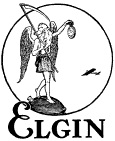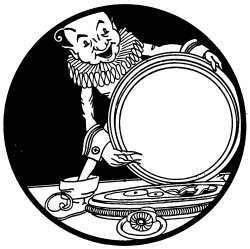The Box of Wonders in Your Pocket, Part 1
 Read Part 2 here
Read Part 2 here

The Box of Wonders in Your Pocket, Part 1
|

|

|
From The Watch Word, November 1935 |
|
||
|
If you knew half the maryelous things which could be told you about your watch, you never again would treat it as casually as you probably do now. For you would realize that it is one of the most extraordinary things made by human hands. A watch is a veritable box of wonders. Many of its parts must be so exact that they are measured by the thickness of a hair. It contains exquisitely made screws, so small that half a million of them will not weigh more than one pound! Twenty thousand of these screws will go into an ordinary thimble. Yet you expect this almost incredibly delicate mechanism to do what no other machine in the world can do. You expect it to run twenty-four hours a day, seven days a week, fifty-two weeks a year, for an indefinite number of years. |
|
|||
|
And think of the conditions under which you ask it to perform this service! It must run just the same, whether the mercury is twenty degrees below zero or one hundred degrees above, whether the air is saturated with moisture or as dryas the desert. It must run in any position-and its position is almost constantly changing. It must stand all kinds of jolts and jars. Part of the mechanism strikes 18,000 blows an h 0 u r; over 150,000,000 beats a year! The movement of a locomotive's wheels is slow and clumsy in compansonyet they are oiled every few hours. One tiny drop of oil is all that a watch asks; but thousands of persons deny it even that much care. The mainspring is the driving force of your watch. It is enclosed in a brass ,case, called the barrel, and this barrel itself is hidden under a metal plate which covers about half of the movement. If the mainspring were straightened out it would be about two feet long. If you tried to take a watch apart and should let that spring escape from the barrel, you would need to look out for your eyes, for it can strike a blow with force enough to cost you your sight. If the mainspring breaks, your watch will stop immediately. Just why these springs do break is a good deal of a mystery. Curiously enough, a first-class spring, with plenty of "ginger," is not the one that can be safely guaranteed against breaking; while a softer spring, which will not do its work so well, is relativelv break-proof. A comparatively soft spring will go on running almost indefinitely. But it acts like any flabby, sickly thing. It does not keep a watch running with precision. It is easily disturbed by shock or strain. It cannot keep up its gait, and you have to wind it oftener. It may be guaranteed not to break; but what is the use of having it stay on the job if it doesn't do the job right? Listen to the tick of your watch, and you can tell pretty accurately whether you have a good mainspring or not. If it has a faint, listless tick, you may suspect it of not being up to the mark. If the tick is clear and sharp and energetic, the spring is a good worker. Yet it may break at any moment-no one knows just why. Electrical and atmospheric conditions seem to have some effect on it. Watch repairers usually have an increased mainspring business after a severe thunderstorm. At other times, the spring breaks without any apparent cause whatever. Shocks and jars do not seem to account for the trouble. The break may come in the night, when your watch is reposing. Even a new spring may break within a week; or it may run for years. But don't ask that a spring be guaranteed for years. Remember that a cheap, soft spring can be guaranteed against breaking, while a better one cannot. From the mainspring, the power travels through a series of four wheels, called the train, to the balance wheel. Three of these wheels are of brass, with toothed edges. The teeth must be absolutely exact in size; yet in many watches they measure only two thousandths of an inch in diameter, midway between their base and their point. |
||||
|
But the balance is the most extraordinary of all the marvels in this box of wonders. It is the heart of your watch. The adjustment of the balance wheel, and of the hairspring which is inside of it, is what makes a watch "keep time." And most of your watch trouble comes from I so m e d erangement of the balance. |
|
|||
|
|
The hairspring is literally as fine as a hair; and an average human hair is only a few thousandths of an inch in diameter. The spring is of steel wire, drawn down gradually to the point where it looks like a thread from a spider's web. At the final stage it is drawn through a tiny hole that has been drilled in a diamond. The diamond is used because it is the hardest of known substances. One hundred miles of this wire can be drawn' through it without wearing the edges of the hole in the diamond; whereas only three or four miles of wire can be drawn through a pierced steel plate without impairing the perfection of the process. A pound of the steel used for this wire costs five or six dollars. A single pound makes eight miles of hairspring wire and is then worth sixty-two thousand dollars! |
|||
|
This threadlike wire is wound by machine into coils. They are then put into a chemical bath, from which they emerge looking like coils of fine brown hair. These coils are tempered, or "blued," by being laid on a hot iron plate for a few seconds. Then they go to workers, who pick up each one with delicate tweezers, and fasten the end with a pin which is itself scarcely larger than a hair. There are 211 pieces in one of our standard size watches, and about onethird of these are screws. Some of the screws in the smaller watches are so minute that 20,000 of them will go into a thimble. Laid on a piece of paper, they look like gold dust. There are steel screws so fine that they look like coarse grains of pepper. Yet everyone of these atoms of steel or gold is a perfect screw, with the spiral thread of a groove cut into it, and with a slot in the head. And everyone of these screws is inspected separately for defects before being used. With the naked eye one can scarcely see that they are screws. A magnifying glass is required to detect possible flaws. The gold screws just mentioned go into the rim of the balance wheel. If your watch is running, you cannot see that they are screws, the wheel moves so rapidly . Yet these specks are essential to the accurate running of every watch. In the first place, the rim of the balance wheel is formed by welding a circle of brass to the outer side of a circle of steel, the brass part being twice as thick as the steel part. Why not have the wheel entirely of brass, or of steel? Brass expands more rapidly under heat than steel does. So we put a brass rim outside the steel one and we cut the rim in two places, leaving two little open spaces. Then, when the brass expands, the steel draws the free ends inward, keeping the wheel the same size. As there would be a variation of only a few' thousands of an inch anyway, you can understand what delicate accuracy of adjustment is involved. |
||||
|
|
In the rim of the balance wheel we pierce twenty-six holes. They are so small that they look like mere b I a c k specks; yet each one of them is accurately grooved in a spiral thread to receive one of those microscopic g 0 I d screws. When the balance wheel is made, six of the little screws are put into six Some of the screws in holes on each side a watch are so small f h h I I that 20,000 of them 0 t e w ee, twe ve will go into an ordi· altogether. The n nary thimble. It take8 583.333 to weigh one the wheel must be pound avoi,·dupoi8. poised, as we call Yet each one is perfectly fini8hed, with a it. To do this, it is beveled head, a 810t, and a 8piral thread- suspended between and weigh8 only t II h twelve.thousandth8 of wo sma uprig ts, a grain/ with thin blades of sapphire or ruby on top, and is made to revolve in that position. The person making the test watches the wheel as it comes to a stop, and if it stops dead in all positions he knows that the weight of the wheel is evenly distributed around the rim. If it does not stop dead, but settles a trifle one way or the other, there must be a little extra weight somewhere. So he takes one pair of screws out of the wheel, weighs them, and substitutes another pair of a slightly different weight, and thus makes the wheel poise exactly. The scales he uses are so delicate that they will weigh a pencil mark on a scrap of tissue paper. The little aluminum pan in which the screws are placed to be weighed, is itself so light that it is enclosed in a glass cylinder, because a breath of air would blow it away. |
|||
|
That gives you some conception of the wonderful tools and equipment necessary in the making of your watch. They represent an achievement even more remarkable than the making of the watch itself. But we are not through with the balance, even yet. After all the parts of a watch have been assembled, and the "movement" is ready to run, it is tested In vanous ways, You wear your watch winter and summer, and you expect it to run just the same all through the year. So one of the tests is for temperature. The completed movement is kept running for twenty-four hours in an oven at a temperature of about eighty-four degrees; and for another twenty-four hours in an electric refrigerator at a temperature below freezing. Suppose it is found to have gained two seconds at one temperature and lost five at the other. That is a total error of seven seconds. The man who is "rating" the watch, takes out one pair of those little screws in the rim of the balance wheel and moves them a hole or two farther along. Each of the twelve holes in the two sides of the balance rim has a number. The watch rater may move the screws in the Number Eight holes to Number Five, and make a note of this change in his record book. Then he repeats the twenty-four hour tests at each temperature to see whether he has corrected the error. If he .has not, he makes another change in the position of some of the screws, and tries the test again. He may add another pair of screws. But he keeps on until the watch runs the same at every temperature. | ||||
|
||||
|
|
||||

|
|
|||
|
|
||||
Comments to jsexton@elgintime.com